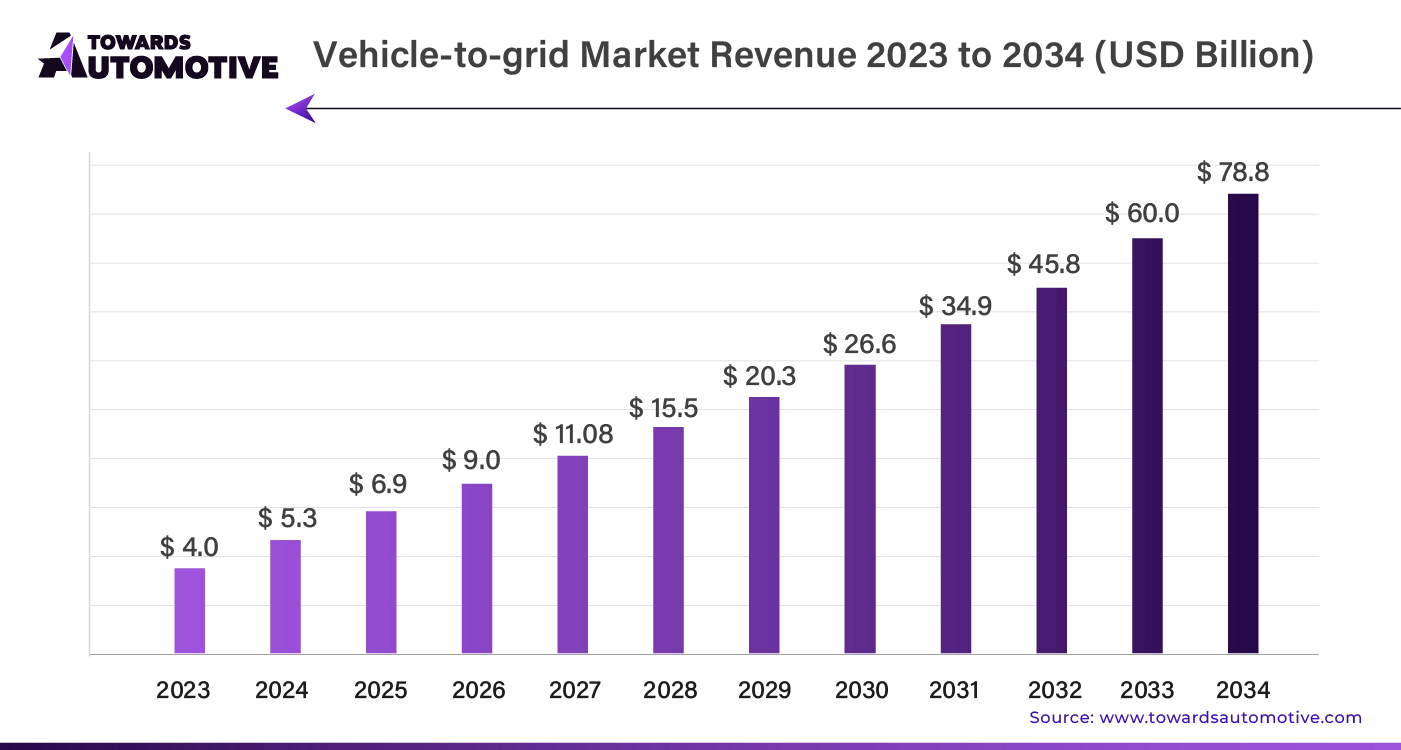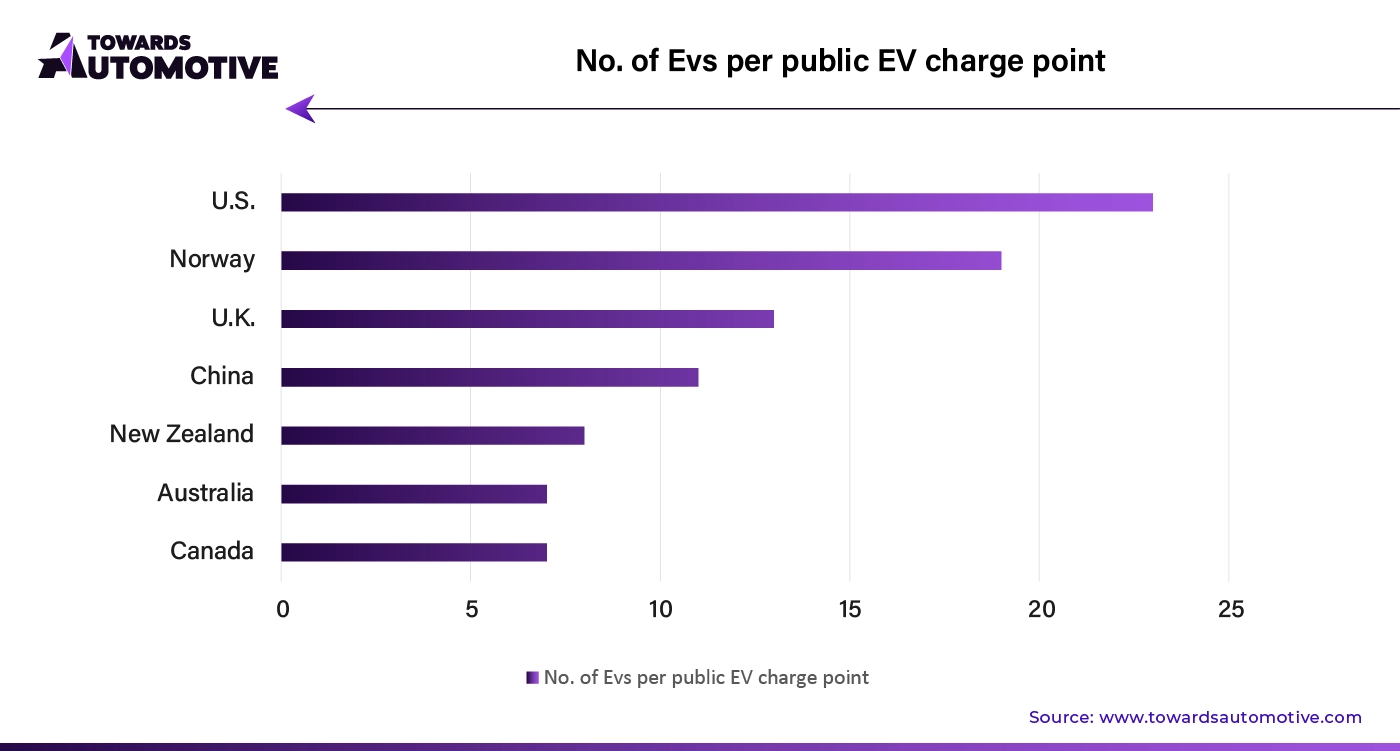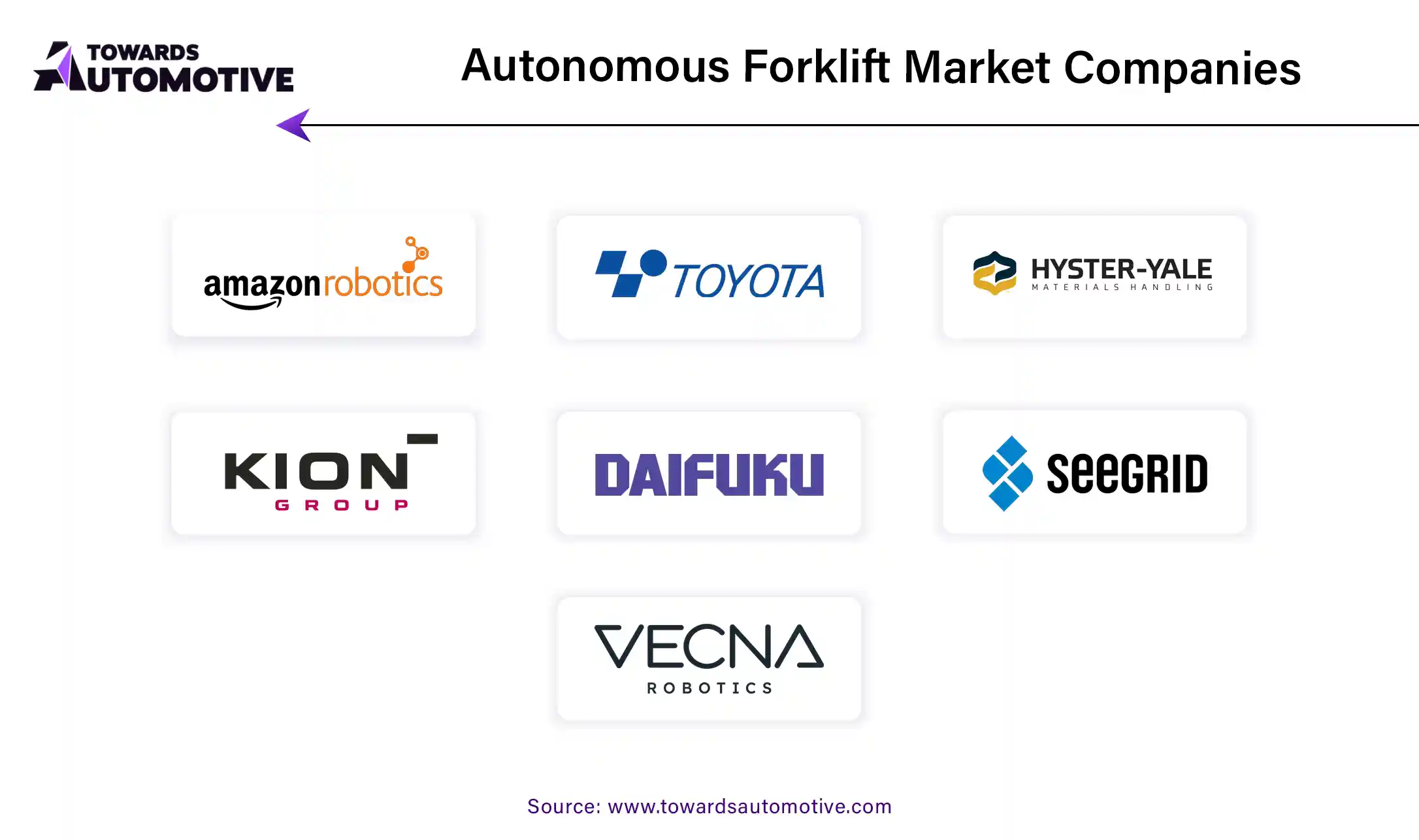October 2025
The vehicle-to-grid (V2G) market is set to grow from USD 6.9 billion in 2025 to USD 78.8 billion by 2034, with an expected CAGR of 31.1% over the forecast period from 2025 to 2034.

The transition towards a sustainable energy future is gaining momentum, driven by the increasing focus on sustainability and the need for innovative solutions to address global energy challenges. Among these solutions, electric vehicles (EVs) are playing a pivotal role. Their advanced battery technology is not only enhancing vehicle performance but also enabling a new paradigm in energy management through Vehicle-to-Grid (V2G) systems.
The Role of Electric Vehicles and V2G Technology
Electric vehicles are at the forefront of this energy transformation. By leveraging their sophisticated battery technology, EVs are capable of storing and redistributing energy. This capability is central to V2G technology, which allows EVs to interact with the power grid, providing valuable services such as energy storage and grid stabilization.
V2G technology is emerging as a key enabler of a decentralized energy ecosystem. It facilitates the integration of renewable energy sources by storing excess energy when supply exceeds demand and redistributing it when needed. This not only supports the development of renewable energy but also contributes to a more resilient and flexible energy grid. The automotive market valued at USD 4,070.19 billion in 2023, is experiencing growth and is projected to surpass USD 6,678.28 billion by 2032, with a significant CAGR of over 5.66%.
Incentives and Government Support
Governments and regulatory bodies are actively promoting the adoption of V2G technology. Various legislative measures, incentives, feed-in tariffs, tax credits, and infrastructure requirements are being implemented to encourage the integration of V2G systems. These policies are designed to support the growth of V2G technology and make it more accessible to both consumers and businesses.
Cost Reductions and Financial Benefits
One of the significant advantages of V2G technology is the potential for cost reductions. As battery technology improves and becomes more affordable, the initial investment required for participating in V2G programs decreases. This makes V2G systems more accessible to a broader range of EV owners, enhancing the overall adoption of this technology.
V2G systems also contribute to demand response strategies, which help manage peak demand and prevent grid overloads. By enabling distributed energy storage and flexible loads, V2G systems play a crucial role in maintaining grid stability and efficiency.
Technological Advancements and Future Prospects
Ongoing advancements in V2G technology are continuously enhancing its efficiency and value proposition. Improvements in charging infrastructure, optimization algorithms, and communication protocols are driving the development of more effective and user-friendly V2G systems.
The growth of V2G technology is also creating new business opportunities and revenue streams. Utilities, EV owners, aggregators, and technology companies are exploring innovative ways to capitalize on the benefits of V2G systems, contributing to a dynamic and evolving energy market.
Artificial Intelligence (AI) is set to revolutionize the Vehicle-to-Grid (V2G) market by driving efficiency and optimizing grid interactions. AI algorithms can analyze vast amounts of data from electric vehicles (EVs) and the grid to predict energy demand, vehicle availability, and optimal charging and discharging times. This predictive capability allows for more effective management of energy resources, reducing grid congestion and improving stability.
AI also enhances user experience by enabling smart charging solutions. By learning from driving patterns and energy consumption, AI can suggest the best times for EVs to charge or discharge, balancing energy needs with cost-efficiency. Furthermore, AI can facilitate real-time communication between vehicles and the grid, allowing for immediate adjustments based on current conditions.
These advancements contribute to market growth by making V2G systems more reliable and appealing to both consumers and energy providers. As AI continues to evolve, its role in managing and integrating renewable energy sources with electric vehicles will become increasingly critical, further driving the expansion and adoption of V2G technologies.
The supply chain in the vehicle-to-grid (V2G) market is a dynamic network integrating multiple stages to ensure seamless energy flow between electric vehicles (EVs) and the grid. Initially, manufacturers produce advanced EV batteries with V2G capabilities, which involves sourcing raw materials, assembly, and quality control. These vehicles then enter the market and are distributed through automotive dealerships.
Once on the road, EVs equipped with V2G technology connect to the grid, providing stored energy during peak demand and receiving energy during off-peak hours. This interaction is facilitated through a network of charging infrastructure and smart grid technology.
Supply chain management in this market involves coordinating with battery suppliers, vehicle manufacturers, energy providers, and technology developers to ensure compatibility and efficiency. This requires real-time data integration, forecasting, and robust logistics to manage the distribution of components and finished products. Additionally, regulatory compliance and customer support play crucial roles in maintaining a smooth supply chain.
Overall, the V2G supply chain is essential for advancing sustainable energy solutions and optimizing energy consumption, necessitating collaboration and innovation across all stakeholders.
The vehicle-to-grid (V2G) market ecosystem consists of several critical components, each playing a distinct role in the integration of electric vehicles (EVs) with the power grid. Central to this system are the EVs themselves, equipped with advanced battery storage systems capable of bi-directional energy flow. These batteries are developed by companies specializing in battery technology, such as Tesla and Panasonic, ensuring high performance and reliability.
Charging infrastructure is another vital component, involving smart chargers and grid interfaces that allow for efficient energy exchange between vehicles and the grid. Companies like ChargePoint and Blink contribute to this by developing and deploying a network of charging stations equipped with V2G capabilities.
Energy providers and grid operators, such as Siemens and Enel, integrate V2G technology into the existing grid infrastructure. They develop software and systems for grid management and demand response, optimizing the balance between supply and demand.
Technology developers and data analytics firms offer platforms to monitor and manage the V2G interactions, ensuring that energy flow is both efficient and cost-effective. Companies like Nuvve and Fermata Energy lead in this space, providing the technology that enables real-time energy trading and grid stabilization.
Together, these components and companies form a cohesive V2G ecosystem, driving forward the future of sustainable energy and smart grid solutions.
Integration of Vehicle-to-Grid Systems with Home Energy Management Solutions
Vehicle-to-Grid (V2G) systems are increasingly becoming a pivotal part of smart grid infrastructure. By enabling bidirectional energy flow between electric vehicles (EVs) and the grid, V2G technology transforms EVs into distributed energy resources. This integration supports the grid through various functions such as load balancing, peak shaving, and frequency regulation. Essentially, EVs can contribute to grid stability and efficiency by providing additional power during peak periods and storing energy during off-peak times.
Adoption of Vehicle-to-Grid Technology in Electric Vehicle Fleets
The rise in electric vehicle adoption globally is accelerating the deployment of V2G systems. As fleets of EVs expand, there is a significant opportunity to aggregate their battery storage for grid services. This collective capacity allows utilities to better manage energy demand, reduce peak loads, and enhance overall grid operations. The integration of V2G technology into large EV fleets not only supports grid stability but also offers a way for fleet operators to potentially earn revenue by participating in energy markets.
Renewable Energy Integration and Its Impact on Sales
The shift toward renewable energy sources—such as solar and wind power—benefits greatly from V2G systems. EV batteries can store surplus renewable energy generated during periods of high production and release it when renewable generation is low. This capability helps to smooth out the fluctuations in renewable energy output, ensuring a more stable and reliable grid. By enhancing the integration of intermittent renewable sources, V2G systems play a crucial role in advancing the energy transition and supporting the growth of renewable energy markets.
Technical and Operational Challenges Affecting Growth
Despite the promising potential of V2G systems, several technical and operational challenges could impact their effectiveness. Issues such as system complexity, reliability concerns, and performance variability need to be addressed. Key challenges include managing bidirectional power flow, ensuring grid stability, and implementing real-time control mechanisms. Overcoming these hurdles requires advanced technical solutions and well-defined operational protocols to ensure that V2G systems can operate safely and efficiently.
United States: Accelerating the Transition to Sustainable Energy
In the United States, the rising adoption of electric vehicles (EVs) is creating a significant opportunity to utilize EV batteries for grid services and energy storage. The U.S. government’s support for clean energy initiatives, along with regulatory incentives and funding programs, is propelling the development of Vehicle-to-Grid (V2G) infrastructure.
Key players in the automotive, energy, and technology sectors are heavily investing in V2G research, development, and pilot projects. These initiatives aim to showcase the benefits of bidirectional power flow between EVs and the grid. The expansion of smart grid technologies, improved integration with renewable energy sources, and enhanced energy management systems are all contributing to a promising future for V2G in the United States.
Despite the positive outlook, several challenges need to be addressed for widespread V2G adoption. These include issues related to interoperability, regulatory barriers, and consumer acceptance. However, V2G technology holds the potential to revolutionize the U.S. energy landscape by improving grid resilience and supporting the shift towards a sustainable, decentralized energy future.
China: Leveraging Manufacturing Strength for Large-Scale V2G Deployment
China is at the forefront of the global electric vehicle (EV) market, making it a key player in the development of Vehicle-to-Grid (V2G) technology. The country’s robust manufacturing infrastructure supports large-scale production and deployment of V2G systems, driven by substantial government backing for electric mobility and renewable energy.
Government policies, including subsidies, incentives, and supportive policy directives, are fostering a favorable environment for V2G technology. Major automotive, energy, and technology firms are investing in V2G research and pilot projects to demonstrate the technology’s feasibility and benefits.
Advancements in smart grid infrastructure, energy management systems, and renewable energy integration are further boosting the V2G market in China. However, challenges such as maintaining grid stability, ensuring interoperability, and navigating regulatory frameworks remain significant hurdles that need to be overcome to fully realize the potential of V2G technology.

United Kingdom: Policy-Driven Growth in V2G Technology
The United Kingdom is witnessing notable progress in Vehicle-to-Grid (V2G) technology, driven by its ambitious goals to decarbonize the transportation sector and integrate renewable energy sources. V2G technology is becoming increasingly crucial for balancing grid demand and managing intermittent renewable energy.
Automakers, energy companies, and technology providers in the UK are actively engaging in pilot projects and trials to highlight the advantages of bidirectional energy flow between electric vehicles and the grid. With supportive government policies and a strong focus on sustainability, V2G technology is set to play a pivotal role in transforming the UK’s energy landscape.
The ongoing innovation and investment in V2G systems reflect the UK's commitment to achieving a sustainable and resilient energy future. By addressing current challenges and leveraging policy support, the UK is well-positioned to lead the way in V2G technology adoption.

Shift Towards Economical Travel: The Rise of Electric Vehicles
In the quest for cost-effective and environmentally friendly transportation options, battery electric vehicles (EVs) are becoming increasingly prominent. A key feature of EVs is their role in the Vehicle-to-Grid (V2G) market, which enables a dynamic two-way energy exchange between vehicles and the power grid.
Understanding Vehicle-to-Grid (V2G) Technology
In a V2G system, EV batteries can store surplus electricity from the grid during times of low demand. This stored energy can then be fed back into the grid when demand peaks or during high-usage periods. This bidirectional flow of electricity allows EVs to act as distributed energy resources, supporting the grid in several critical ways:
Participation in V2G programs offers EV owners opportunities to earn revenue or receive incentives, transforming their vehicles into valuable grid assets. As the adoption of EVs grows and V2G infrastructure expands, this technology is expected to significantly enhance energy management, optimize grid operations, and bolster grid stability and resilience.
The Crucial Role of EVSE in Promoting Electric Vehicles
Electric Vehicle Supply Equipment (EVSE) is integral to the widespread adoption of EVs. By supporting the necessary infrastructure for charging, EVSE helps to reduce greenhouse gas emissions and combat climate change. Several factors are contributing to the growing prominence of EVSE:
As EVSE technology continues to advance and the infrastructure expands, it is anticipated that these factors will further boost the adoption of electric vehicles, supporting the transition to a more sustainable and economically viable transportation system.
In the rapidly evolving vehicle-to-grid (V2G) industry, leading companies are leveraging advanced strategies to stay ahead of the curve. These companies are prioritizing life cycle assessments and investing significantly in research and development to create cost-effective applications for rare earth metals, essential for V2G technology. By forming strategic partnerships and collaborations, these companies are able to pool their expertise and resources, driving innovation and enhancing their market positions. Notable players in this sector include AC Propulsion, Inc., Edison International, DENSO CORPORATION, Boulder Electric Vehicle, and Nissan.
To meet the growing demand for V2G solutions, these key companies are expanding their operations into regions with high demand. They are also diversifying their product offerings, particularly by developing europium-based components tailored to specific applications. Furthermore, a strong emphasis on environmentally friendly manufacturing and processing practices is helping these companies comply with regulatory standards and foster sustainability. By focusing on these areas, leading manufacturers are not only driving industry growth but also promoting innovation and sustainable practices within the sector.

By Vehicle Type
By Components
By Technology
By Charging Type
By Region
October 2025
October 2025
October 2025
October 2025
We offer automotive expertise for market projections and customizable research, adaptable to diverse strategic approaches.
Contact Us